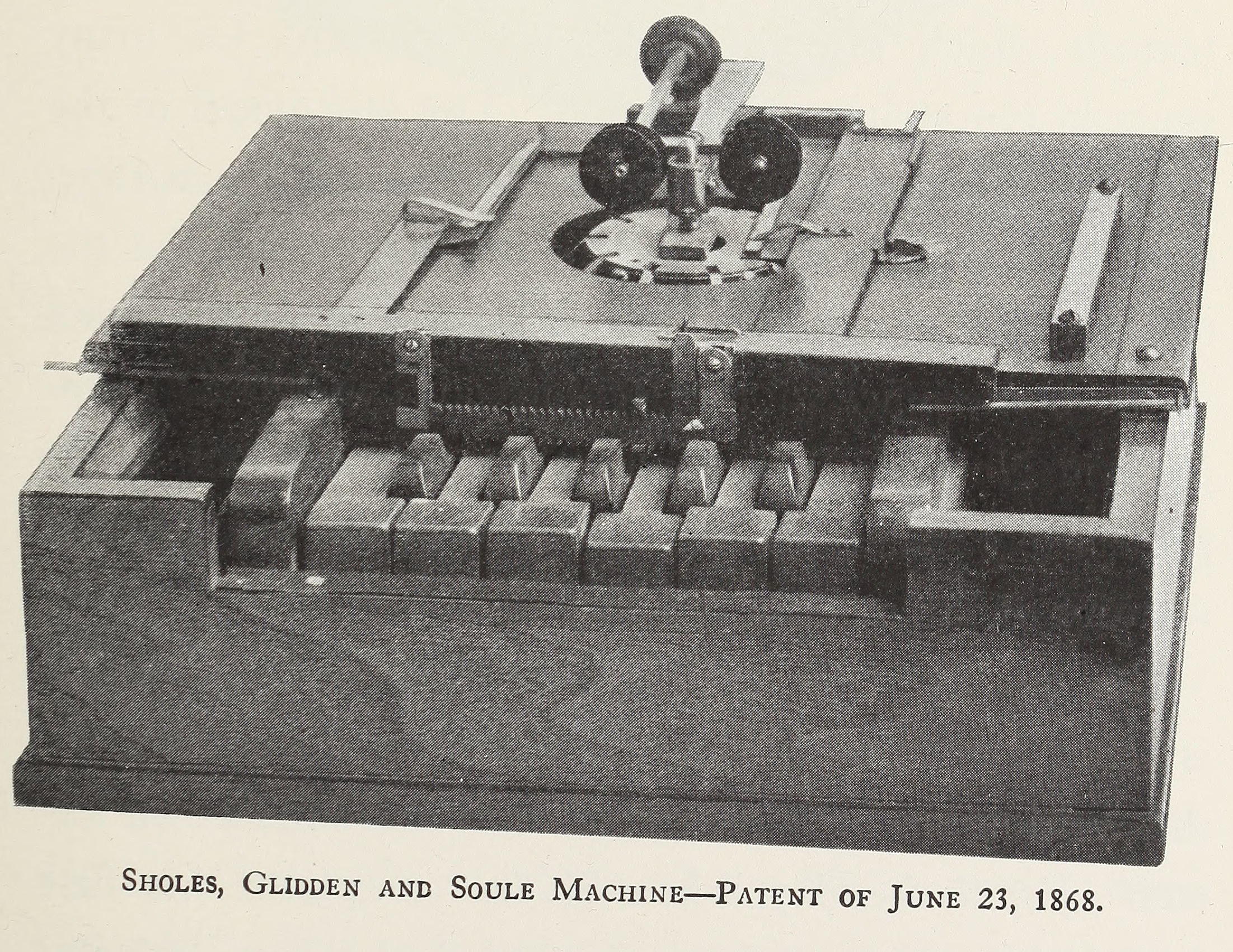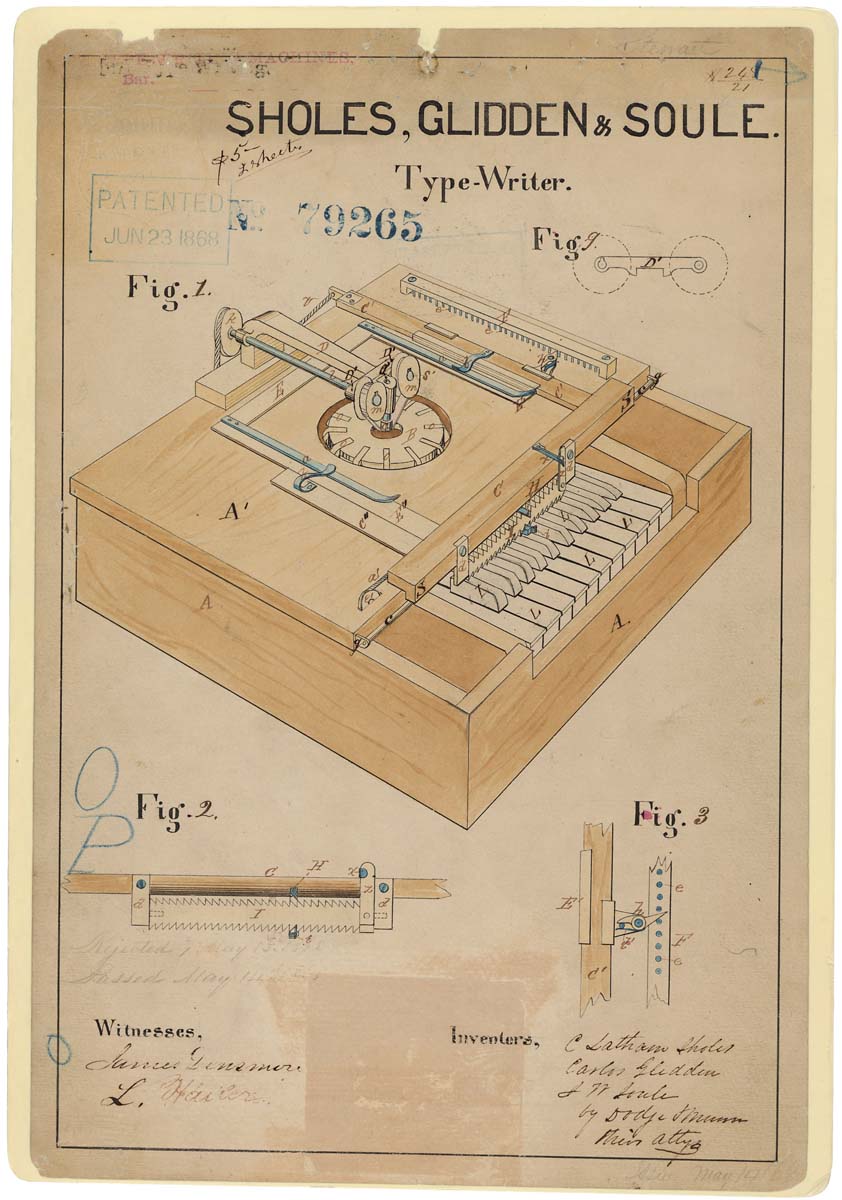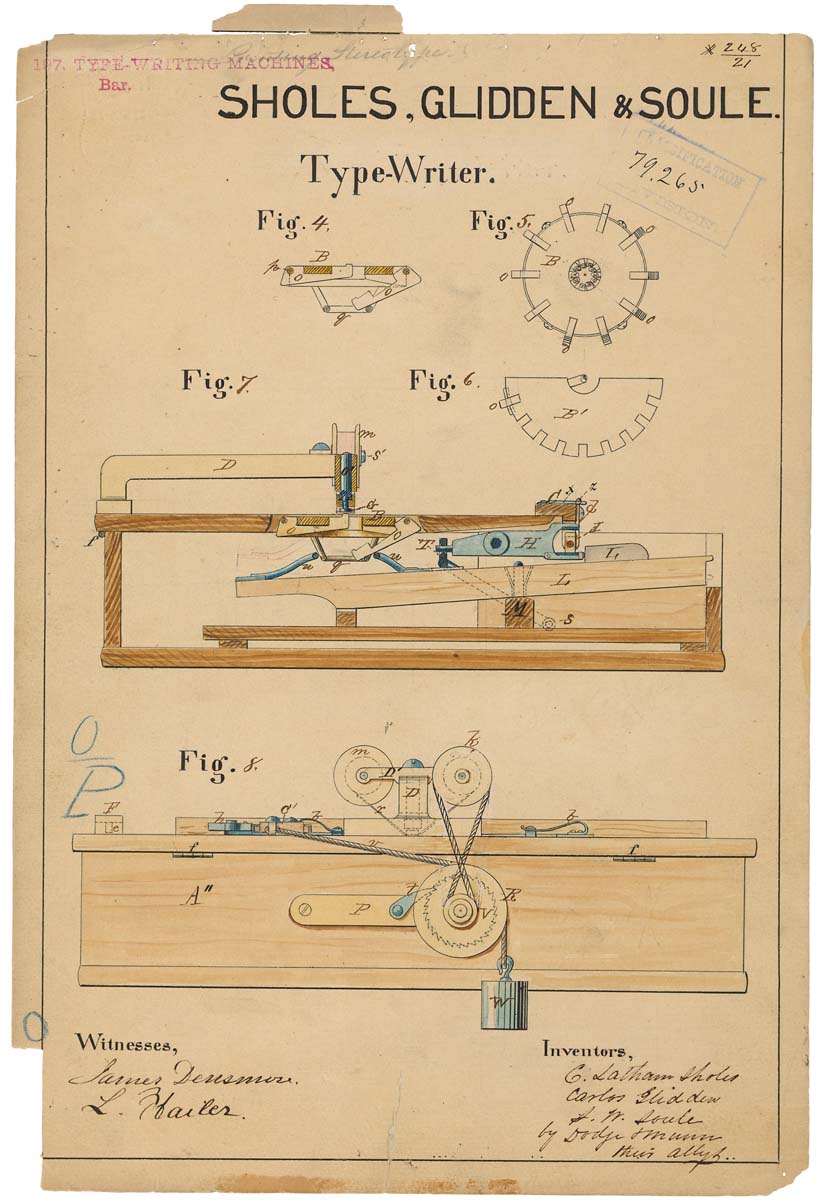【Taro Kai Archives】
Life Before QWERTY
On Technology

The history of the typewriter is, as with the history of the personal computer after it, rife with collaboration, ingenuity, betrayal, setbacks, lucre, acrimony, misguided experimentation, and bickering white men. There are rough analogs for Bill Gates and for Steves Jobs and Wozniak (though there’s no one so delirious and insane as Steve Ballmer)—and one such analog is Christopher Latham Sholes, a Milwaukee printer whose first “type-writer” was patented 146 years ago today.
Sholes is widely credited with having invented the first QWERTYkeyboard. It helped to prevent jams and increase typing speeds by putting frequently combined letters farther apart—but that took years of trial and error; the initial iteration of his typewriter was far more rudimentary in design. It looks like a miniature piano crossed with a clock and/or a phonograph and/or a kitchen table—and Sholes did, in fact, design the prototype out of his kitchen table. As you can imagine, it didn’t boast what today’s designers would call “intuitive UX.” Its keys, borrowing from innovations in telegraphy, were arranged as such:
3 5 7 9 N O P Q R S T U V W X Y Z
2 4 6 8 . A B C D E F G H I J K L M
Notice the absence of 0 and 1; Sholes and his cohort assumed that people would make do with Iand O. They also couldn’t be bothered with lowercase letters—the first Sholes model was in a condition of eternal caps lock, doomed to permanent shouting. And yet in another sense Sholes was full of intuition and prescience: purportedly, the first letters he typed on the machine were “WWW.” George Iles’s 1912 book, Leading American Inventors, describes the mechanics:
The first row is of ivory, duly lettered; the second row is of ebony; and then, as you see, a third row, made up of letters and characters that are little used, is in the form of pegs. The framework is of wood, with the leverage below, and the basket form of typebars above closely resembles those of some machines in use today. The original model was very clumsy and weighty. The writing was on a tape of tissue paper, and the platen was fastened to the body of the boxlike affair. The writing could not be seen till it was completed, and when the document was once removed from the machine there was no way by which it could be replaced with any degree of certainty that the lines would correspond with those previously written.
 As an early developer declared, “It was good for nothing except to show that its underlying principles were sound.” But its technical advances, enumerated below, were enough to earn it a patent, and to attract the attention of investors and fellow inventors:
As an early developer declared, “It was good for nothing except to show that its underlying principles were sound.” But its technical advances, enumerated below, were enough to earn it a patent, and to attract the attention of investors and fellow inventors:
(1) A circular annular disc, with radial grooves and slots to receive and guide the typebars so that they struck the center. (2) Radial typebars to correspond with this disc. (3) A ratchet to move the paper-carriage by the breadth of a tooth when a key was struck. (4) A hinged clamp to hold the paper firmly on its carriage.
Sholes was intent on winning over the stenographer demographic—he assumed such workers were the likeliest customers, and that they would do the most to improve the product—so he did the natural entrepreneurial thing and hired a consultant. He sent James Ogilvie Clephane, a renowned court reporter in Washington, D.C., an early model and told him to give it hell. Clephane did; so unforgiving was his field-testing that he destroyed a succession of costly prototypes, and he told Sholes in no uncertain terms that his typewriter was garbage. But his brutal feedback began the long process that culminated in the QWERTYdesign.
Not that this was a cakewalk; Sholes and his companions went through years of prototypes, and fell deeply into debt, before they arrived at a marketable model, and even then, in 1874, no one really wanted the typewriter, known by that point as the Remington 1. It cost $125, a small fortune for the day, and typewritten correspondence was stigmatized as impersonal and impolite. Sholes faced competition from a league of rival manufacturers, many of whom he’d once worked with.
 Still, in its incipient form, Sholes’s machine was at least fun to develop. Leading American Inventorsincludes this bucolic account of work in the Milwaukee mill where he held court with his colleagues, Carlos Glidden and Samuel Soule:
Still, in its incipient form, Sholes’s machine was at least fun to develop. Leading American Inventorsincludes this bucolic account of work in the Milwaukee mill where he held court with his colleagues, Carlos Glidden and Samuel Soule:
In that grimy old mill on the Rock River Canal there were interludes to lighten and brighten the toil of experiment. All three partners were chess players of more than common skill, and they often turned from ratchets and pinions to moves with knights and pawns. Ever and anon a friend would drop in, and the talk would drift from writing by machinery to Reconstruction in South Carolina, or to the quiet absorption by farms and mills of the brigades mustered out after Appomattox. Then, with zest renewed, the model was taken up once more, to be carried another stage toward completion. One morning it printed in capitals line after line both legibly and rapidly. Sholes, Soule, and Glidden were frankly delighted.
Today the site is marked with a reverent plaque, courtesy of the Milwaukee County Historical Society, which buoyantly claims that “C. Latham Sholes perfected the first practical typewriter.” Would that it were so.
Search
Categories
Latest Posts
The Palace and the Storm
2025-06-26 00:35Aamer Hussein on 'The Cloud Messenger' by Jonathan Gharraie
2025-06-26 00:19Kate Beaton on ‘Hark! A Vagrant’ by Nicole Rudick
2025-06-25 23:49'SNL' cancels Pete Davidson
2025-06-25 22:54Radiating Racism
2025-06-25 22:20Popular Posts
The Reboot of the Elites
2025-06-26 00:19Other People's Churches by Rachael Maddux
2025-06-25 23:38Part 1: The Amanuensis by Mark Van de Walle
2025-06-25 23:05Cosmic Geometry by Lauren O'Neill
2025-06-25 22:09Juggalos, Nevertheless Persisting
2025-06-25 22:00Featured Posts
Lost in Boston
2025-06-26 00:07Twitter meme 'knows a spot' for some absolutely terrible dates
2025-06-25 23:58The 27 Guy Fieriest Guy Fieri tweets of 2020, so far
2025-06-25 23:18Didion’s Details by Leslie Jamison
2025-06-25 22:49Brand on the Run
2025-06-25 22:31Popular Articles
So Much Winning
2025-06-26 00:22Bluesky Social invite code: How to get yours
2025-06-26 00:04Abstracts by Scott Treleaven
2025-06-25 23:47The Perishable Politician
2025-06-25 23:21Newsletter
Subscribe to our newsletter for the latest updates.
Comments (99851)
Belief Information Network
Surveillance Valley
2025-06-26 00:25Micro Video Information Network
Bluesky Social invite code: How to get yours
2025-06-25 23:41Creation Information Network
Wordle today: Here's the answer and hints for May 1
2025-06-25 23:37Fashion Information Network
Twitter keeps logging you out? What we know
2025-06-25 23:08Thought Information Network
Zucktown, USA
2025-06-25 22:48